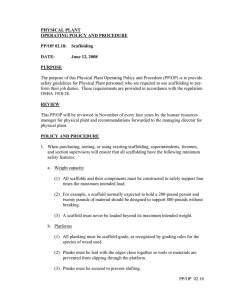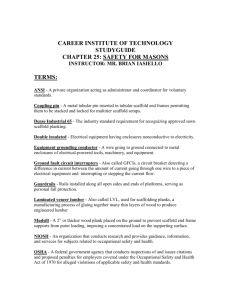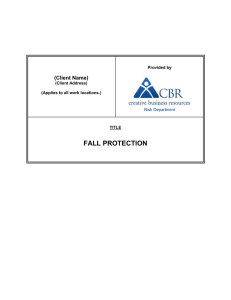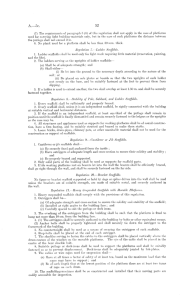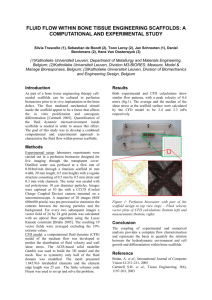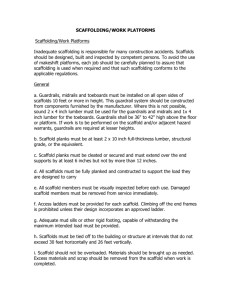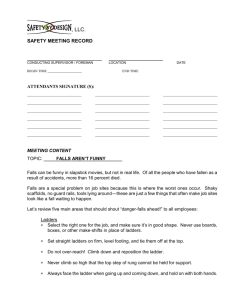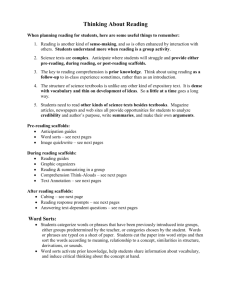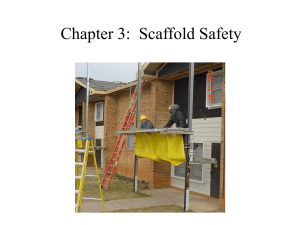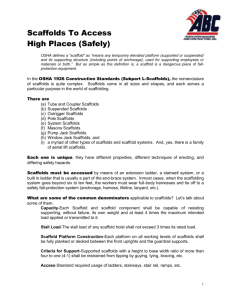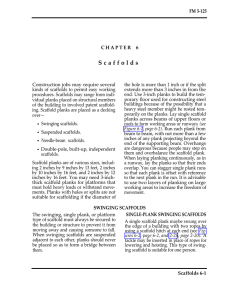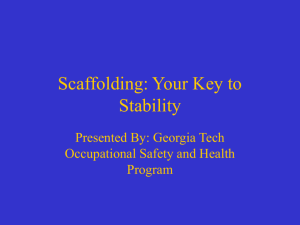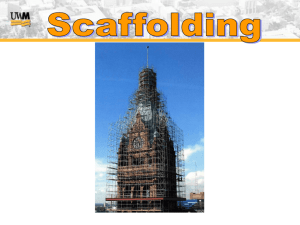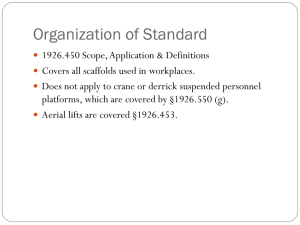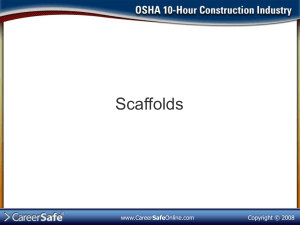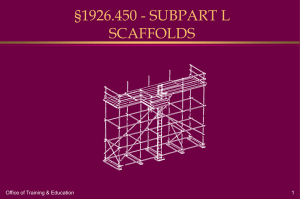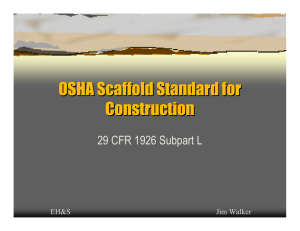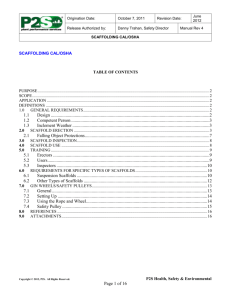Scaffolding
advertisement
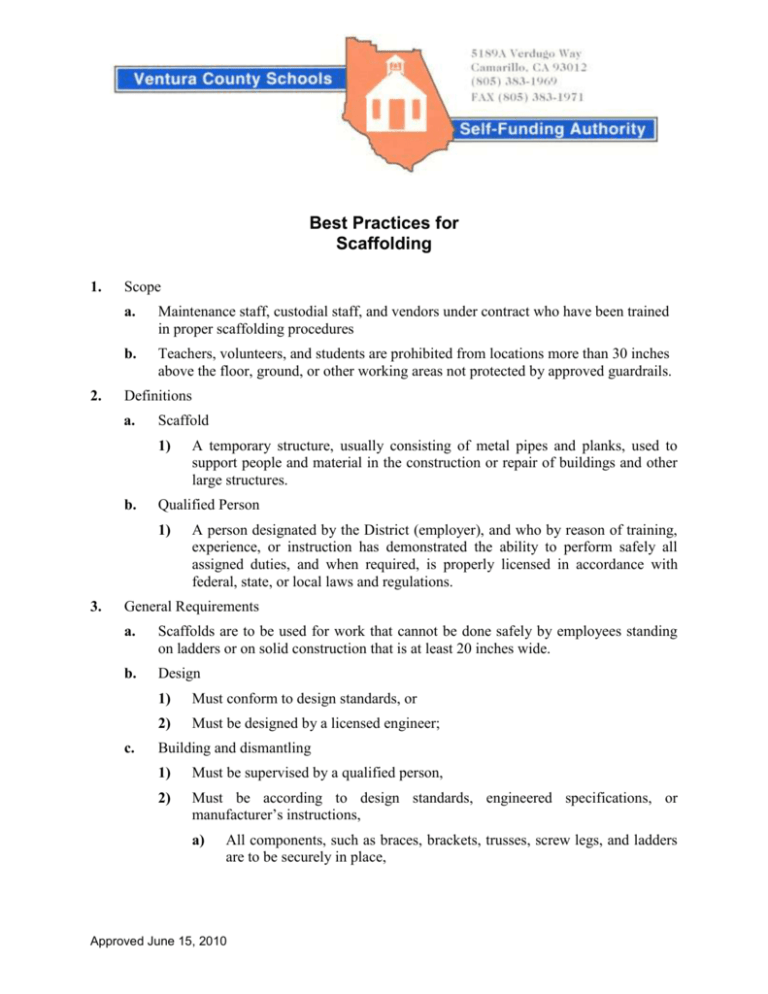
Best Practices for Scaffolding 1. 2. Scope a. Maintenance staff, custodial staff, and vendors under contract who have been trained in proper scaffolding procedures b. Teachers, volunteers, and students are prohibited from locations more than 30 inches above the floor, ground, or other working areas not protected by approved guardrails. Definitions a. Scaffold 1) b. Qualified Person 1) 3. A temporary structure, usually consisting of metal pipes and planks, used to support people and material in the construction or repair of buildings and other large structures. A person designated by the District (employer), and who by reason of training, experience, or instruction has demonstrated the ability to perform safely all assigned duties, and when required, is properly licensed in accordance with federal, state, or local laws and regulations. General Requirements a. Scaffolds are to be used for work that cannot be done safely by employees standing on ladders or on solid construction that is at least 20 inches wide. b. Design c. 1) Must conform to design standards, or 2) Must be designed by a licensed engineer; Building and dismantling 1) Must be supervised by a qualified person, 2) Must be according to design standards, engineered specifications, or manufacturer’s instructions, a) All components, such as braces, brackets, trusses, screw legs, and ladders are to be securely in place, Approved June 15, 2010 Scaffolding Page 2 b) d. the scaffolding components from different 3) Scaffolds, including components, that are damaged or weakened are to be repaired or replaced immediately, 4) A Cal/OSHA permit is required for building and dismantling scaffolds that exceed three (3) stories or 36 feet in height; Access 1) 2) 3) e. Never interchange manufacturers, Ladders may be used if the following applies: a) Follow “Best Practices for Ladders,” b) Ladders are to comply with Cal/OSHA regulations, c) Ladders are to be securely attached to scaffolds, d) Ladders are to extend three (3) feet above the platform, or handholds are to be provided Horizontal members built into the end frame of a scaffold may be used to access platforms if the following applies: a) The horizontal members are parallel and level, b) The horizontal members make a continuous ladder, bottom to top, with the ladder sides of the frames in a vertical line, c) The horizontal members provide sufficient clearance for a good handhold and foot space; Stairways are to conform to the following: a) Permanent stairways are to comply with Cal/OSHA regulations, b) Pre-fabricated scaffold stairs are to comply with ANSI 10.8-1988; Scaffolds are to be secured as follows: 1) Tied off with a double-looped no. 12 iron wire or a single-looped no. 10 iron wire, 2) Metal scaffolds are to be tied off at intervals not to exceed 30 feet horizontally and subject to the following: a) Ties are required at the free ends of the scaffold when the height of the scaffold platform exceeds 3 times the least base dimension. The remaining ties of the first row are required when the height of the scaffold platform is four times the least base dimensions, b) Ties for subsequent levels are to be installed at 26-foot intervals vertically, with the last tie no further from the top than four times the least base dimension, Scaffolding f. Page 3 c) As an alternate means, scaffolds are to be guyed or outriggers shall be used to prevent tipping or upsetting, d) Wind Loading. When scaffolds are partially or fully enclosed, specific precautions are to be taken to assure the frequency and adequacy of ties attaching the scaffolding to the building; 3) Light-trade wooden pole scaffolds are to be tied off every 20 feet horizontally and vertically; 4) Heavy-trade wooden pole scaffolds are to be tied off every 15 feet horizontally and vertically. Platforms 1) Platforms are to be capable of supporting the intended load weight; 2) Platforms are to be planked solid (without gaps) and cover the entire space between scaffold uprights; a) Exception. In solid planking the following gaps are permissible: i. 3) 4) g. i) Metal scaffolds: 16 inches maximum, ii) Wood scaffolds: 14 inches maximum; Minimum widths: a) Light trades: 20 inches, b) Heavy trades: four (4) feet; Platform surfaces are to be slip-resistant. Planking 1) Scaffold grade lumber with a nominal dimension of 2 x 10 inches, 2) Maximum span: 3) 4) h. Space between the building or structure and the platform: a) Light trades @ 25 pounds per square foot (psf) = 10 feet, b) Medium trades @ 50 psf = 8 feet, c) Heavy trades @ 75 psf = 7 feet; Overhang a) Six (6) inch minimum, b) 18 inch maximum; A single plank is permitted only on platforms up to four (4) feet high. Guardrails are to be installed on open sides and ends of platforms that are 7½ feet or higher. Scaffolding Page 4 a) 42 inches tall b) Must withstand 200 pounds c) Midrail d) Toeboard i. 4. Four (4) inches tall i. Toe boards are required on all railed sides of work surfaces where employees work or pass below. j. Overhead protection is required when people are working overhead. Scaffold-Specific Requirements The requirements listed below are unique to each type of scaffold listed, and they replace or augment the general requirements. a. Tower and rolling scaffolds 1) The height to base ratio is not to exceed 3:1 unless the scaffold is secured. 2) Wheels or casters a) Two (2) are to swivel, b) All four (4) are to lock; 3) All frame and center joints are to be locked together by lock pins, bolts, or equivalent fastenings. 4) The scaffold is to have cross bracing and horizontal diagonal bracing. 5) The scaffold is to have a fully planked platform. 6) Railings are required if the platform is 7½ feet or more above the grade. a) 7) Refer to paragraph 3.h. The following conditions are to exist if employees ride on a rolling scaffold: a) The minimum dimension of the base is at least half of the height, i. b. c. If outriggers are used, they must be installed on both sides. Horse Scaffolds 1) Width of base legs = ½ x height (minimum). 2) Height a) Collapsible horse = six (6) feet maximum b) Single horse = 10 feet maximum Ladder Jack Scaffolds 1) Ladders are to be industrial, Type 1A: 300 pounds. Scaffolding Page 5 2) Each ladder is to be secured to prevent falling. 3) A safety line is required for each worker. 4) Specifications: a) Span = 16 feet maximum, b) Height = 16 feet maximum, c) Width = 14 inches minimum, d) Load weight capacity = two workers maximum.

